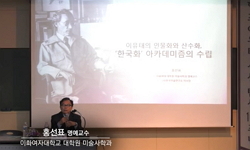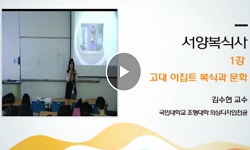Igor Stravinsky(1882-1971)는 신고전주의를 주도한 작곡가중의 한사람으로 이 논문의 주제인 Suite Italienne가 만들어진 원곡인 Pulcinella는 Stravinsky의 신고전주의 경향이 처음으로 나타나기 시작하던 ...
http://chineseinput.net/에서 pinyin(병음)방식으로 중국어를 변환할 수 있습니다.
변환된 중국어를 복사하여 사용하시면 됩니다.
- 中文 을 입력하시려면 zhongwen을 입력하시고 space를누르시면됩니다.
- 北京 을 입력하시려면 beijing을 입력하시고 space를 누르시면 됩니다.
Igor Stravinsky의 Suite Italienne 분석연구 = (An) analysis study on the Stravinsky's Suite italienne
한글로보기https://www.riss.kr/link?id=T7336694
- 저자
-
발행사항
서울 : 이화여자대학교 대학원, 1999
-
학위논문사항
학위논문(석사) -- 이화여자대학교 대학원 , 음악학과 , 1999. 8
-
발행연도
1999
-
작성언어
한국어
- 주제어
-
KDC
675.2 판사항(4)
-
발행국(도시)
서울
-
형태사항
iv, 49 p. : 삽도 ; 26cm.
-
일반주기명
참고문헌 수록
- 소장기관
-
0
상세조회 -
0
다운로드
부가정보
국문 초록 (Abstract)
Igor Stravinsky(1882-1971)는 신고전주의를 주도한 작곡가중의 한사람으로 이 논문의 주제인 Suite Italienne가 만들어진 원곡인 Pulcinella는 Stravinsky의 신고전주의 경향이 처음으로 나타나기 시작하던 시기의 작품이다. 이러한 Suite Italienne를 분석함으로써 작품에 나타난 Stravinsky의 신고전주의적 경향을 검증함과 동시에 그의 신고전주의에 있어서 이 곡이 차지하는 중요성을 연구 분석해 보았다.
이 곡의 형식은 AB 또는 ABA´로 구성되었으며, 축소나 변형, 확대 없이 대부분 규칙적이고 단순한 형식으로 이루어져 있어 고전적인 형식미를 느낄 수 있다. 그러나 특징적으로 제 4곡 Gavotta는 Variation형식이나 주제부와 동일한 구성으로 구성되어 있다.
조성은 주로 major가 사용되었고 제 2곡과 4곡에서는 minor 가 사용되었다. 전조는 주로 원조의 Dominant조와 나란한조( Relative key)로 이루어졌다. 화성은 I와 V위주의 간결하고 단순한 진행으로, 특히 Tonic과 Dominant가 Pedal point로 강조되어 지속적으로 나타난다. 주로 3화음위주의 화음진행에 7화음이 나타나며 Secondary 화음이나 변화화음은 거의 사용되지 않았다. 종지도 V → I 위주의 정격종지가 명확하게 나타나며, 변격종지나 허위종지는 사용되지 않았다.
선율은 주로 순차 위주의 명확하고 단순한 구조로, Phrase의 구성도 4마디로 이루어진 것이 대부분이다. 그러나 제 3곡 Tarantella 와 5곡 Scherzino에서는 불규칙한 구조의 선율과 반복음으로 현대적인 느낌이 강하게 나타나고 있으며, 그 이외에는 고전적인 아름답고 조성감이 강한 선율이 주로 사용되고 있다.
구성 면에서는 화성적인 성격이 강하게 나타나며, 대위법적인 진행은 주로 모방을 통해 가끔씩 나타나고 있다. 리듬은 역시 단순하고 규칙적이지만 Syncopation rythem이 가끔 나타나 변화를 주고 있다.
이상의 특징에서 간결한 형식, 규칙적 구조와 조성, I와 V위주의 단순한 화성, 순차진행위주의 아름다운 선율, 화성적인 구조의 piano 반주 등이 신고전주의적인 작품을 명확하게 나타나고 있다. 그러나 Violin 의 자유로운 음역사용, 특히 Tonic과 Dominant pedal point의 강조, Syncopation rythem 및 타악기적인 반복음의 사용 등에서 Stravinsky의 특징도 함께 나타나고 있다.
다국어 초록 (Multilingual Abstract)
The 19th Century was the age of absolutism and humanism based on the rationalism. This social condition brought the opportunity of expansion of sensitivity and subjectivity throughout the trend of art. Romanticism became the main trend of Music inst...
The 19th Century was the age of absolutism and humanism based on the rationalism. This social condition brought the opportunity of expansion of sensitivity and subjectivity throughout the trend of art. Romanticism became the main trend of Music instead of Classicism in 19th Century. In 20th Century, radical changes by mechanization, materialism, massacre, and environment pollution influenced the trend of art. In this situation, Neo-Classism tried to make a new order on the tradition, including new factors instead of expression of sensitivitism. The composers of Neo-Classicism denied the subjective expression of sensitivity of Romanticism in 18th Century, and tried to established the absolute music which has thematic proceedings, balanced formation, and subjectivity based on the model of Baroque and Classicism.
Igor Stravinsky(1882-1971) was one of the leading composer of Neo-Classicism, and Suite Italienne coming from Pulcinella was the work of the beginning of his Neo-Classicism Period. By annalizing Suite Italienne, Stravinsky´s trend of Neo-Classicism can be identified and the importance of Suite Italienne can be proved.
The formation of Suite Italienne is AB or ABA´ and is simple and regular, which gives classical beauty of formalism. Simple tonality, regular structure, simple harmony and the order of beautiful melody clearly identifies the trend of Neo-Classicism.
목차 (Table of Contents)
- 목차
- 논문개요
- Ⅰ. 서론 = 1
- 1. 연구의 목적 = 1
- 2. 연구의 범위와 방법 = 2
- 목차
- 논문개요
- Ⅰ. 서론 = 1
- 1. 연구의 목적 = 1
- 2. 연구의 범위와 방법 = 2
- Ⅱ. 본론 = 3
- 1. I. Stravinsky와 신고전주의 = 3
- A. 신고전주의의 발생배경 = 3
- B. I. Stravinsky와 신고전주의 = 5
- C. Pullchinella 와 I. Stravinsky의 신고전주의 = 7
- 2. Suite Italienne 분석 = 8
- A. Introduzione = 10
- B. Serenata = 15
- C. Tarantella = 18
- D. Gavotta = 25
- E. Scherzino = 31
- F. Minuetto e Finale = 36
- Ⅲ. 결론 = 45
- 참고문헌 = 46
- 영문초록 = 48










